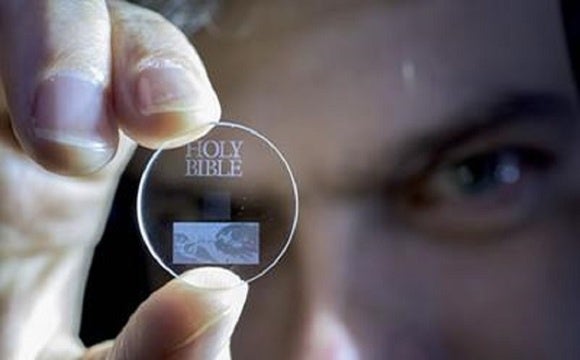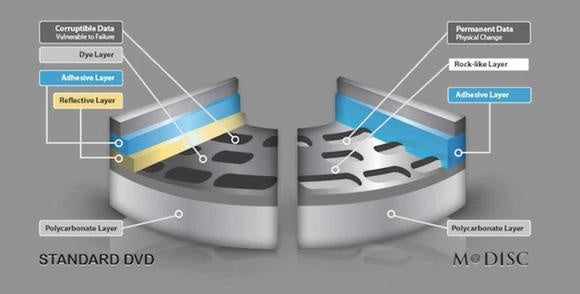
Researchers at the University of Southampton in the U.K. say they’ve been able to etch some of mankind’s most famous documents on a “5-dimensional” crystalline storage medium estimated to have a lifespan of billions of years.
The researchers used self-assembled nanostructures created in fused quartz crystal to store data in five “dimensions,” writing each file in three layers of nanostructured dots separated by five micrometers of blank space. The data is encoded using the standard three dimensions of width, height, and depth. The fourth and fifth “dimensions” assign values to the size of the data “dot,” and how it is aligned.
That all works out to a theoretical data capacity of 360 terabytes that can be stored in the dimensions of a conventional disc, like a DVD, the researchers said. The fused quartz essentially lasts forever, or 13.8 billion years at 190 degrees centigrade. It’s also thermally stable up to 1,000°C, the researchers claim.
Why this matters: The Superman comics and movies showed how the native Kryptonians stored their stored knowledge on crystals, which young Kal-El (Superman) was able to access in his Fortress of Solitude. So yes, it’s really pretty cool to see these “Superman crystals” become reality. What we truly need, though, is an archival storage medium that can be read decades down the road. Who has a floppy disc drive any more? Or even a CD-ROM reader? The cloud is one solution, but only if we trust our personal information will be safe for generations in the hands of businesses who may or may not care that our digital lives are preserved.
A permanent record
The problem with the media that we’ve come to associate with computers is that most older formats simply aren’t permanent. According to the National Archives, magnetic media (tape) typically last between 10 and 50 years. Pressed discs, such as you might buy as a game or a piece of software, may last “generations” if preserved well. But recordable discs can be unreadable in as little as a year, if the organic dyes used to store your data deteriorate to the point where they become unreadable.

M-DISC
M-Disc technology, which is now supported by numerous Blu-ray and DVD burners, was created to solve this problem, too. It uses an inorganic layer as a way to preserve your data even longer—up to 1,000 years, the company claims. But each disc only holds 4.7GB, and a 50-pack (or a bit more than 200GB) costs $140. (M-Disk also supports 100-GB Blu-ray compatible discs, for $20.50.) But that’s the price you’ll pay for near-permanent data storage.
That’s the goal that the Southampton researchers also hope to accomplish.
“It is thrilling to think that we have created the technology to preserve documents and information and store it in space for future generations,” said Professor Peter Kazansky of the university’s Optoelectronics Research Center, in a statement. “This technology can secure the last evidence of our civilization: All we’ve learnt will not be forgotten.”
The 5D “Superman crystals” technology was first proven out in 2013, when a 300-kilobit file was encoded. Now, the researchers have encoded the Universal Declaration of Human Rights, Newton’s Opticks, the Magna Carta, and the King James Bible using the technology.
The Southampton team plans to present a paper on the subject at the International Society for Optical Engineering Conference in San Francisco this week, where hopefully questions will be asked and answered on two issues: exactly how fast data is encoded and read, and the projected cost of such a solution. The researchers also say that they’re looking for a company to help commercialize the technology.
The Southampton ORC released a video showing the encoding process, which uses what the researchers claim is a “ultrafast” laser. However, it’s just not clear how fast data can be read and written to the medium.
Still, the goal here is to create a permanent means of storing information, not a fast one. if such a process could be made viable, it’s not impossible to believe that humanity could build another Great Library of knowledge, one that could last virtually forever.
Correction: An earlier version of this story implied that M-Disc only supported 4.7-GB DVDs; the format supports up to 25-, 50-, and 100-GB Blu-ray discs,
[“source -pcworld”]




